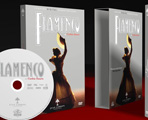Finally released in DVD, with all the honors, this classic flamenco documentary «Flamenco» (1995) of Carlos Saura.
|
What more could you ask? by Juan Vergillos
This film has much to offer. The artists and their performances were carefully calculated to keep an even pace: every centimeter of film is essential. The most noteworthy interpreters of the era file across the screen under the naked gaze of Storaro, so that it is practically impossible to cite highlights beyond one’s own personal taste. Even so, we can’t resist briefly recalling several sequences: the close-up of Paquera with her bulerías war-cry; no one had ever before portrayed the singer in such a truthful way. Or the sensual warmth of Merche Esmeralda. The categorical rhythm of Diego Carrasco. The earthy moaning of Agujetas and the gut-wrenching silence that follows. Never before had a martinete been filmed in such starkness. The serene visceral quality of Toronjo. The existential crunch of Fernanda de Utrera, the only artist, along with Chano Lobato, who also appeared in Neville’s “Duende y Misterio del Flamenco (1952)” the lone predecessor to this work. Fernanda de Utrera’s interpretation is possibly the most moving moment of “Flamenco”: an unvarying close-up, almost institutional, breaks the soleá to pieces, this essential voice, the most important of the century that just ended, naked artifice and technical resources, almost voiceless, in the pure skeleton of cante: an essential truth. |
